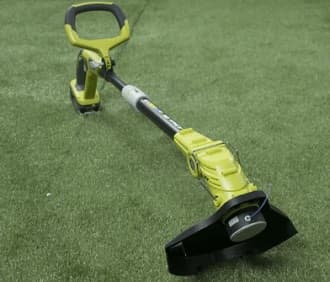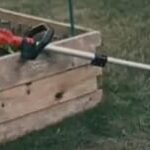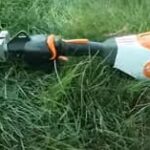As an Amazon Associate, this site earns commissions from qualifying purchases. For more information click here.
The auto feed on a Ryobi string trimmer usually works without any problems. But every now and then you might run into some issues. There are many reasons why this could happen, so we conducted research and compiled the best solutions.
If the string is not wound properly, the auto feed will not work. The feed will also stop if the string or spool are damaged. The spinning head might also be filled with debris.
Before you try any of these tips, please check your Ryobi string trimmer owner’s manual. Follow any troubleshooting guides and observe safety precautions.
String Wound Incorrectly
The string inside a Ryobi string trimmer goes around a spool. It is linked to a spring. When the head strikes a surface, the spring causes the spool to release more string.
If the string is not wound correctly however, the feed will not work. This problem often arises when replacement string is too loose. When you turn the trimmer on and the head starts to spin, the loose string gets tangled and blocks the system.
If the line is too tight, the string gets stuck together and the spinning head runs into problems. This can also happen if the replacement string is too large.
How to fix it. Check your string trimmer diameter. Choose a replacement string that is exactly that size. Wound it carefully. This takes patience but is an effective solution. This method works with the Ryobi 18V Cordless String Trimmer and other models.
Faulty Spring
When you hit the head of a Ryobi string trimmer, it is the spring that makes the spool release more string. Through heavy and constant use, its springiness wears out and the spring can no longer make the spool produce additional string.
If the spool is damaged and not replaced, it will eventually damage the spring as well. The two are integrated and if one part malfunctions, the other gets affected too. This can happen not just with Ryobi but other string trimmers too.
How to fix it. Turn off the string trimmer and take the spool out. Take a look at the spring and test its springiness. If it is no longer springy, replace it.
Check the Ryobi website as there should be spring replacement parts available. Make sure it is compatible with your string trimmer make and model.
Faulty Spool
The spool holds the string, so if it warps or breaks, the auto feed trimmer will stop working. A broken spool cannot spin and the feed mechanism will halt.
The spool wears out through regular use, but hitting the head too hard can cause damage. If the spool is already worn out and you bump the head hard to make it release the string, it will just make things worse.
How to fix it. Clean the spool every time you replace the string. No special cleaning need, just wipe the dirt and debris with a cloth.
Check the spool for signs of damage. If the spool is warped, cracked or bent, replace it. Do not wait for problems to arise before buying a new spool. Go to the official Ryobi website. Search for your string trimmer make and model spool replacement.
Wrong Trimmer Line Size
String trimmer lines have to be a specific size to run on the auto feed. If you choose the wrong one, the trimmer could lock up. Worse, using the wrong trimmer line can damage the spool or the spring.
If you need to replace the trimmer line, go online and look up your specific string trimmer make and model. Use only an exact match for your trimmer to avoid this kind of problem. So if you have the Ryobi ZRP2003A, make sure that the replacement is an exact match for this model.
Dirty or Damaged Spinning Head
String trimmer spinning heads can get clogged with weed, grass, dirt, dust and other debris. The auto feed will run into problems if it is blocked and likely halt.
The cutting heads on a heavily used string trimmer can break off. This will also damage the auto feed system.
How to fix it. If you have an old trimmer, wear and tear will occur at some point. However, regular maintenance is going to prolong the life of your trimmer.
But once you notice signs of damage on the spool or spring, replace them immediately. Do the same with the cutting heads. Install the new part following the instructions provided to you.
If there is no damage, regular cleaning will suffice. Thorough cleaning will go far in keeping your string trimmer fully functional.

Damaged Trimmer Casing
Check the trimmer head housing for signs of damage. Cracks, warping, bending, chipping etc. Even a small crack can spread quickly if not handled right away. Do not neglect that small crack you see because the next time you use the trimmer, that could suddenly expand.
How to fix it. Damaged housing or casing cannot be fixed. It has to be replaced. Just like with other Ryobi tools, you should be able to find a replacement for your particular string trimmer model.
Defective Spool Retainer Cap
The spool retainer cap is the part that connects the spool to the trimmer shaft. Due to wear and tear, damage or other reasons, the cap gets stuck. This occurs when the bolt inside the cap is too tight and the auto feed cannot move.
How to fix it. Some have suggested replacing the entire head assembly, but that is not going to work. What you need to do is loosen the bolt.
To loosen the bolt, you have to get inside the cap. How you do this depends on what type of string trimmer you have. Loosen the bolt so the spring and spool can move freely.
Loosening the bolt is not too hard, but it is going to take some trial and error to determine how loose it has to be. If the auto feed does not function properly, loosen the bolt a bit more. Keep doing this until you get the right consistency.
Other Possible Reasons
Those cited above are the most likely culprits for Ryobi auto feed trimmer problems. But if you tried them all and it still won’t run, here are few more that you may consider.
- The line got stuck on the spool
- The string is worn too short
- There is not enough line left
- The line got tangled with itself
You can check the spool and spring to verify these. If you have determined that it is so, there are a number of things you can do to fix it.
- If the line got tangled or stuck to itself, use a silicone spray. There are products available specifically for this.
- If the line has gotten too short, press and hold the button. Pull the line at the same time.
- If the string got stuck on the spool, just take out the entire line and wound it again. This is important to prevent future problems.
- Lastly if there is not enough string in the feed, add more. Finding new trimmer lines is easy, but you have to install it correctly.
String Trimmer Maintenance Tips
Clean after each use. It might be a chore to clean up after every use, but it’s good practice. By removing dirt, grass and debris regularly, you prevent grime from building up.
If you wait several weeks or months to clean your string trimmer, the debris could get stuck. This makes cleaning harder and a harder task. For the outer parts, wipe with a clean rag. For harder to reach areas, use an air compressor or canned air.
Disconnect the spark plug before cleaning a gas-powered string trimmer. If you use an electric trimmer, unplug from its power source. And when you are done cleaning, store the trimmer in a moisture-free location. The storage area must be dust free as well.
To do this, loosen the bolt a little. Next, secure the spool onto the shaft. Turn the string trimmer on and bump the head a few times. If done

I love the outdoors and all the tools for maintaining gardens, yards and lawns. The only thing I am more passionate about is sharing what I know about garden and outdoor equipment.


